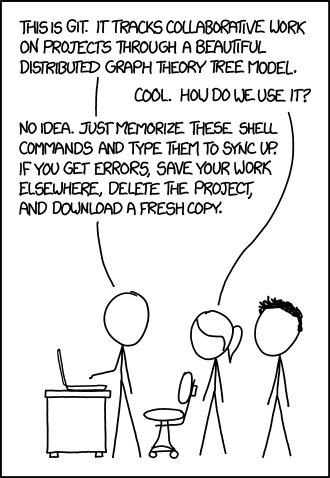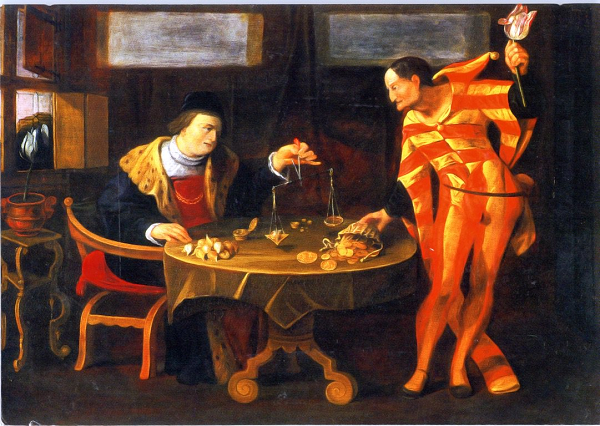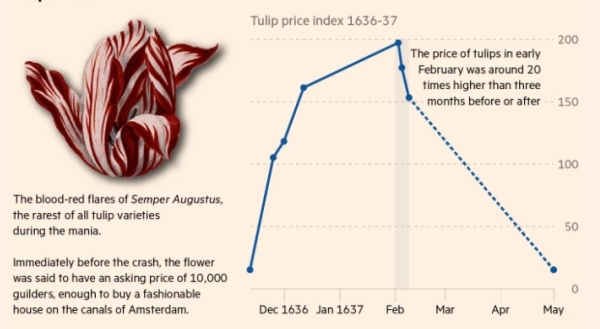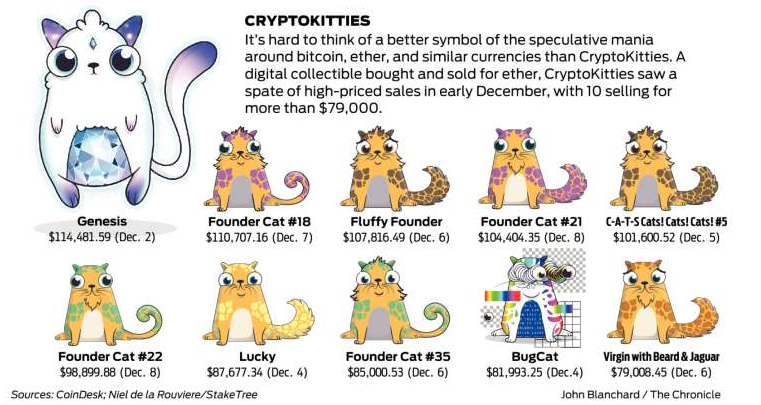Mining Digital Gold one Block at a Time?! • Don't Expect to Get Insanely Rich (Quick) • Tulips 🌷🌷🌷 (like Blockchains) are Great and Gorgeous (and will Endure)
b0 = Block.first(
{ from: "Dutchgrown", to: "Vincent", what: "Tulip Bloemendaal Sunset", qty: 10 },
{ from: "Keukenhof", to: "Anne", what: "Tulip Semper Augustus", qty: 7 } )
b1 = Block.next( b0,
{ from: "Flowers", to: "Ruben", what: "Tulip Admiral van Eijck", qty: 5 },
{ from: "Vicent", to: "Anne", what: "Tulip Bloemendaal Sunset", qty: 3 },
{ from: "Anne", to: "Julia", what: "Tulip Semper Augustus", qty: 1 },
{ from: "Julia", to: "Luuk", what: "Tulip Semper Augustus", qty: 1 } )
...(Source: blockchain_with_transactions.rb)
A collection about awesome blockchains - open distributed databases w/ crypto hashes incl. git ;-). Blockchains are the new tulips 🌷🌷🌷.
Contents:
- Frequently Asked Questions (F.A.Q.s) & Answers
- Do-It-Yourself (DIY) - Build Your Own Blockchain
- Blockchain Articles
- Blockchain Books
- Blockchain (Lite) Crypto Hash Libraries
- Git, Git, Git - The Stupid Content Tracker with Crypto Hashes
- Classic Tulip Mania
- Awesome Awesomeness
Q: What's a Blockchain?
A: A blockchain is a distributed database with a list (that is, chain) of records (that is, blocks) linked and secured by
digital fingerprints (that is, cryptho hashes).
Example from blockchain.rb:
[#<Block:0x1eed2a0
@index = 0,
@timestamp = 1637-09-15 20:52:38,
@data = "Genesis",
@previous_hash = "0",
@hash = "edbd4e11e69bc399a9ccd8faaea44fb27410fe8e3023bb9462450a0a9c4caa1b">,
#<Block:0x1eec9a0
@index = 1,
@timestamp = 1637-09-15 21:02:38,
@data = "Transaction Data...",
@previous_hash = "edbd4e11e69bc399a9ccd8faaea44fb27410fe8e3023bb9462450a0a9c4caa1b",
@hash = "eb8ecbf6d5870763ae246e37539d82e37052cb32f88bb8c59971f9978e437743">,
#<Block:0x1eec838
@index = 2,
@timestamp = 1637-09-15 21:12:38,
@data = "Transaction Data......",
@previous_hash = "eb8ecbf6d5870763ae246e37539d82e37052cb32f88bb8c59971f9978e437743",
@hash = "be50017ee4bbcb33844b3dc2b7c4e476d46569b5df5762d14ceba9355f0a85f4">,
...
Q: What's a Hash? What's a (One-Way) Crypto(graphic) Hash Digest Checksum?
A: A hash e.g. eb8ecbf6d5870763ae246e37539d82e37052cb32f88bb8c59971f9978e437743
is a small digest checksum calculated
with a one-way crypto(graphic) hash digest checksum function
e.g. SHA256 (Secure Hash Algorithm 256 Bits)
from the data. Example from blockchain.rb:
def calc_hash
sha = Digest::SHA256.new
sha.update( @index.to_s + @timestamp.to_s + @data + @previous_hash )
sha.hexdigest ## returns "eb8ecbf6d5870763ae246e37539d82e37052cb32f88bb8c59971f9978e437743"
endA blockchain uses
- the block index (e.g.
1,2,3,4, etc.) and - the block timestamp (e.g.
1637-09-15 20:52:38) and - the block data (e.g.
Transaction Data...) and finally - the hash from the previous block (e.g.
edbd4e11e69bc399a9ccd8faaea44fb27410fe8e3023bb9462450a0a9c4caa1b)
to calculate the new hash digest checksum, that is, the hash
e.g. be50017ee4bbcb33844b3dc2b7c4e476d46569b5df5762d14ceba9355f0a85f4.
Q: What's a Merkle Tree?
A: A Merkle tree is a hash tree named after Ralph Merkle who patented the concept in 1979 (the patent expired in 2002). A hash tree is a generalization of hash lists or hash chains where every leaf node (in the tree) is labelled with a data block and every non-leaf node (in the tree) is labelled with the crypto(graphic) hash of the labels of its child nodes. For more see the Merkle tree Wikipedia Article.
Note: By adding crypto(graphic) hash functions you can "merkelize" any data structure.
Q: What's a Merkelized DAG (Directed Acyclic Graph)?
A: It's a blockchain secured by crypto(graphic) hashes that uses a directed acyclic graph data structure (instead of linear "classic" linked list).
Note: Git uses merkelized dag (directed acyclic graph)s for its blockchains.
Q: Is the Git Repo a Blockchain?
A: Yes, every branch in the git repo is a blockchain. The "classic" Satoshi-blockchain is like a git repo with a single master branch (only).
Let's Build the Tiniest Blockchain in Python Series by Gerald Nash
- Let's Build the Tiniest Blockchain In Less Than 50 Lines of Python (Part 1), July 2016
- Let's Make the Tiniest Blockchain Bigger With More Lines of Python (Part 2), July 2016
Build Your Own Blockchain: A Python Tutorial by Eric Munsing, March 2017, (Source)
Writing a Tiny Blockchain in JavaScript by Xavier Decuyper, July 2017
Building Blockchain in Go Series by Ivan Kuznetsov, (Source)
- Part 1: Basic Prototype, August 2017
- Part 2: Proof-of-Work, August 2017
- Part 3: Persistence and CLI, August 2017
- Part 4: Transactions 1, September 2017
- Part 5: Addresses, September 2017
- Part 6: Transactions 2, September 2017
- Part 7: Network, October 2017
Build Your Own Blockchain (in Python 3) Series by Jack Schultz, (Source)
- Part 1: Creating, Storing, Syncing, Displaying, Mining, and Proving Work, October 2017
- Part 2: Syncing Chains From Different Nodes, October 2017
- Part 3: Writing Nodes that Mine and Talk, November 2017
Learn Blockchains by Building One (in Python) by Daniel van Flymen, September 2017, (Source) -- The fastest way to learn how Blockchains work is to build one
How Does Bitcoin Force Consensus Among Byzantine Generals? by Fabio Akita, November 2017
Node.js Blockchain Imlementation: BrewChain: Chain+WebSockets+HTTP Server by Darren Beck, November 2017, (Source) -- Protecting the tea making ledger from unscrupulous colleagues
Creating Your First Blockchain with Java, Part 1 by Kass, December 2017, (Source)
blockchain-lite - Build your own blockchains with crypto hashes; revolutionize the world with blockchains, blockchains, blockchains one block at a time! by Gerald Bauer, Ruby Advent Calendar 2017 / Day 1, December 2017
merkletree library - Build Your Own Crypto Hash Trees; Grow Your Own Money on Trees by Gerald Bauer, Ruby Advent Calendar 2017 / Day 19, December 2017
centralbank command line tool (and library) - Print Your Own Money / Cryptocurrency; Run Your Own Federated Central Bank Nodes on the Blockchain Peer-to-Peer over HTTP by Gerald Bauer, Ruby Advent Calendar 2017 / Day 24, December 2017
Build your own Blockchain in Javascript/Visualization of Blockchains by Nam Chu Hoai, January 2018
- Blockchain! Blockchain! Blockchain! - Build Your Own Blockchains in JavaScript from Zero (Scratch) by Gerald Bauer, Vienna.js, September 2017
- Blockchain! Blockchain! Blockchain! - Build Your Own Blockchains in Ruby from Zero (Scratch) by Gerald Bauer, Vienna.rb, Dezember 2017
class Block
attr_reader :index
attr_reader :timestamp
attr_reader :data
attr_reader :previous_hash
attr_reader :hash
def initialize(index, data, previous_hash)
@index = index
@timestamp = Time.now
@data = data
@previous_hash = previous_hash
@hash = calc_hash
end
def self.first( data="Genesis" ) # create genesis (big bang! first) block
## uses index zero (0) and arbitrary previous_hash ("0")
Block.new( 0, data, "0" )
end
def self.next( previous, data="Transaction Data..." )
Block.new( previous.index+1, data, previous.hash )
end
private
def calc_hash
sha = Digest::SHA256.new
sha.update( @index.to_s + @timestamp.to_s + @data + @previous_hash )
sha.hexdigest
end
end # class Block
#####
## let's get started
## build a blockchain a block at a time
b0 = Block.first( "Genesis" )
b1 = Block.next( b0, "Transaction Data..." )
b2 = Block.next( b1, "Transaction Data......" )
b3 = Block.next( b2, "More Transaction Data..." )
blockchain = [b0, b1, b2, b3]
pp blockchain(Source: blockchain.rb)
will pretty print (pp) something like:
[#<Block:0x1eed2a0
@index = 0,
@timestamp = 1637-09-15 20:52:38,
@data = "Genesis",
@previous_hash = "0",
@hash = "edbd4e11e69bc399a9ccd8faaea44fb27410fe8e3023bb9462450a0a9c4caa1b">,
#<Block:0x1eec9a0
@index = 1,
@timestamp = 1637-09-15 21:02:38,
@data = "Transaction Data...",
@previous_hash = "edbd4e11e69bc399a9ccd8faaea44fb27410fe8e3023bb9462450a0a9c4caa1b",
@hash = "eb8ecbf6d5870763ae246e37539d82e37052cb32f88bb8c59971f9978e437743">,
#<Block:0x1eec838
@index = 2,
@timestamp = 1637-09-15 21:12:38,
@data = "Transaction Data......",
@previous_hash = "eb8ecbf6d5870763ae246e37539d82e37052cb32f88bb8c59971f9978e437743",
@hash = "be50017ee4bbcb33844b3dc2b7c4e476d46569b5df5762d14ceba9355f0a85f4">,
#<Block:0x1eec6d0
@index = 3,
@timestamp = 1637-09-15 21:22:38,
@data = "More Transaction Data...",
@previous_hash = "be50017ee4bbcb33844b3dc2b7c4e476d46569b5df5762d14ceba9355f0a85f4",
@hash = "5ee2981606328abfe0c3b1171440f0df746c1e1f8b3b56c351727f7da7ae5d8d">]
Comments from the reddit ruby posting:
Wait, so a blockchain is just a linked list?
No. A linked list is only required to have a reference to the previous element, a block must have an identifier depending on the previous block's identifier, meaning that you cannot replace a block without recomputing every single block that comes after. In this implementation that happens as the previous digest is input in the calc_hash method.
What about Proof of Work?
Let's add a proof of work to the blockchain. In the classic blockchain you have to compute a block hash that starts with leading zeros (00). The more leading zeros the harder (more difficult) to compute. Let's keep it easy to compute with two leading zeros (00), that is, 16^2 = 256 possibilites (^1,2). Three leading zeros (000) would be 16^3 = 4_096 possibilites and four zeros (0000) would be 16^4 = 65_536 and so on.
(^1): 16 possibilties because it's a hex or hexadecimal or base 16 number, that is, 0 1 2 3 4 6 7 8 9 a (10) b (11) c (12) d (13) e (14) f (15).
(^2): A random secure hash algorithm needs on average 256 tries (might be lets say 305 tries, for example, because it's NOT a perfect statistic distribution of possibilities).
Example:
def compute_hash_with_proof_of_work( difficulty="00" )
nonce = 0
loop do
hash = calc_hash_with_nonce( nonce )
if hash.start_with?( difficulty )
return [nonce,hash] ## bingo! proof of work if hash starts with leading zeros (00)
else
nonce += 1 ## keep trying (and trying and trying)
end
end
end
def calc_hash_with_nonce( nonce=0 )
sha = Digest::SHA256.new
sha.update( nonce.to_s + @index.to_s + @timestamp.to_s + @data + @previous_hash )
sha.hexdigest
end(Source: blockchain_with_proof_of_work.rb)
Let's rerun the sample with the proof of work machinery added. Now the sample will pretty print (pp) something like:
[#<Block:0x1e204f0
@index = 0,
@timestamp = 1637-09-20 20:13:38,
@data = "Genesis",
@previous_hash = "0",
@nonce = 242,
@hash = "00b8e77e27378f9aa0afbcea3a2882bb62f6663771dee053364beb1887e18bcf">,
#<Block:0x1e56e20
@index = 1,
@timestamp = 1637-09-20 20:23:38,
@data = "Transaction Data...",
@previous_hash = "00b8e77e27378f9aa0afbcea3a2882bb62f6663771dee053364beb1887e18bcf",
@nonce = 46,
@hash = "00aae8d2e9387e13c71b33f8cd205d336ac250d2828011f5970062912985a9af">,
#<Block:0x1e2bd58
@index = 2,
@timestamp = 1637-09-20 20:33:38,
@data = "Transaction Data......",
@previous_hash = "00aae8d2e9387e13c71b33f8cd205d336ac250d2828011f5970062912985a9af",
@nonce = 350,
@hash = "00ea45e0f4683c3bec4364f349ee2b6816be0c9fd95cfd5ffcc6ed572c62f190">,
#<Block:0x1fa8338
@index = 3,
@timestamp = 1637-09-20 20:43:38,
@data = "More Transaction Data...",
@previous_hash = "00ea45e0f4683c3bec4364f349ee2b6816be0c9fd95cfd5ffcc6ed572c62f190",
@nonce = 59,
@hash = "00436f0fca677652963e904ce4c624606a255946b921132d5b1f70f7d86c4ab8">]
See the difference? All hashes now start with leading zeros (00) and the nonce is the random "lucky number"
that makes it happen. That's the magic behind the proof of work.
class Block {
constructor(index, data, previousHash) {
this.index = index
this.timestamp = new Date()
this.data = data
this.previousHash = previousHash
this.hash = this.calcHash()
}
calcHash() {
var sha = SHA256.create()
sha.update( this.index.toString() + this.timestamp.toString() + this.data + this.previousHash )
return sha.hex()
}
static first( data="Genesis" ) { // create genesis (big bang! first) block
// uses index zero (0) and arbitrary previousHash ("0")
return new Block( 0, data, "0" )
}
static next( previous, data="Transaction Data..." ) {
return new Block( previous.index+1, data, previous.hash )
}
}
//////
// let's get started
// build a blockchain a block at a time
b0 = Block.first( "Genesis" )
b1 = Block.next( b0, "Transaction Data..." )
b2 = Block.next( b1, "Transaction Data......" )
b3 = Block.next( b2, "More Transaction Data..." )
blockchain = [b0, b1, b2, b3]
console.log( blockchain )(Source: blockchain.js)
will log something like:
[ Block {
index : 0,
timestamp : 1637-09-18 08:25:54,
data : 'Genesis',
previousHash : '0',
hash : 'c396de4c03ddb5275661982adc75ce5fc5905d2a2457d1266c74436c1f3c50f1' },
Block {
index : 1,
timestamp : 1637-09-18 08:35:54,
data : 'Transaction Data...',
previousHash : 'c396de4c03ddb5275661982adc75ce5fc5905d2a2457d1266c74436c1f3c50f1',
hash : '493131e09c069645c82795c96e4715cea0f5558be514b5096d853a5b9899154a' },
Block {
index : 2,
timestamp : 1637-09-18 08:45:54,
data : 'Transaction Data......',
previousHash : '493131e09c069645c82795c96e4715cea0f5558be514b5096d853a5b9899154a',
hash : '97aa3cb5052615d60ff8e6b41bef606562588c4874f011970ac2f218e2f0f4a8' },
Block {
index : 3,
timestamp : 1637-09-18 08:55:54,
data : 'More Transaction Data...',
previousHash : '97aa3cb5052615d60ff8e6b41bef606562588c4874f011970ac2f218e2f0f4a8',
hash : 'e10e020f832e46c2b60e1c3c0412bd370b2fde5f0f782c16eb87d0313ea0d3a3' } ]
Reflections on the Blockchain by Rufus Pollock (Open Knowledge Foundation), July 2016 -- The DAO: Code is not Law – and It’s Dangerous to Think So ++ The Internet changed the world - surely the Blockchain will too? ++ Gold-rush or Internet-rush? ++ Governance Matters in Bitcoin ++ The Myth of a Costless, Ownerless Network ++ Lessons from History
On the Dangers of a Blockchain Monoculture by Tony Arcieri, January 2016 -- The Bitcoin blockchain: the world's worst database ++ Next-generation protocols ++ Decentralized ledger protocols ++ Bitcoin-NG ++ Blockchain! Blockchain! Blockchain! ++ The great decentralized database in the sky
I Don’t Believe in Blockchain by Tim Bray, May 2017
Minimum Viable Blockchain by Ilya Grigorik, May 2014 -- Securing transactions with triple-entry bookkeeping ++ Securing transactions with PKI ++ Balance = Σ(receipts) ++ Multi-party transfers & verification ++ Double-spending and distributed consensus - Requirements for a distributed consensus network; Protecting the network from Sybil attacks; Proof-of-work as a participation requirement ++ Building the minimum viable blockchain - Adding "blocks" & transaction fee incentives; Racing to claim the transaction fees; Resolving chain conflicts; Blocks are never final ++ Properties of the (minimum viable) blockchain
Blockchains by analogies and applications: How blockchain compares to Git, Raft, and other technologies. by Kieren James-Lubin, January 2016 -- Blockchains are databases ++ Understanding transactions ++ Persistent, replicated databases (related technology: Git) ++ Peer-to-peer networks (related technology: BitTorrent) ++ Distributed consensus (related technology: distributed databases, Raft) ++ Minting new coins (mining) ++ Embedded identities (related technology: TLS) ++ Smart contracts: Like SQL expressions & triggers ++ What can we really do with blockchains?
Attack of the 50 Foot Blockchain: Bitcoin, Blockchain, Ethereum & Smart Contracts by David Gerard, London, 2017 -- What is a bitcoin? ++ The Bitcoin ideology ++ The incredible promises of Bitcoin! ++ Early Bitcoin: the rise to the first bubble ++ How Bitcoin mining centralised ++ Who is Satoshi Nakamoto? ++ Spending bitcoins in 2017 ++ Trading bitcoins in 2017: the second crypto bubble ++ Altcoins ++ Smart contracts, stupid humans ++ Business bafflegab, but on the Blockchain ++ Case study: Why you can’t put the music industry on a blockchain
Mastering Bitcoin - Programming the Open Blockchain 2nd Edition, by Andreas M. Antonopoulos, 2017 - FREE (Online Source Version) -- What Is Bitcoin? ++ How Bitcoin Works ++ Bitcoin Core: The Reference Implementation ++ Keys, Addresses ++ Wallets ++ Transactions ++ Advanced Transactions and Scripting ++ The Bitcoin Network ++ The Blockchain ++ Mining and Consensus ++ Bitcoin Security ++ Blockchain Applications
Programming Cryptocurrencies and Blockchains in Ruby ( Beta / Rough Draft ) by Gerald Bauer et al, 2018 - FREE (Online Version) @ Yuki & Moto Press Bookshelf -- Digital $$$ Alchemy - What's a Blockchain? - How-To Turn Digital Bits Into $$$ or €€€? • Decentralize Payments. Decentralize Transactions. Decentralize Blockchains. • The Proof of the Pudding is ... The Bitcoin (BTC) Blockchain(s) ++ Building Blockchains from Scratch - A Blockchain in Ruby in 20 Lines! A Blockchain is a Data Structure • What about Proof-of-Work? What about Consensus? • Find the Lucky Number - Nonce == Number Used Once ++ Adding Transactions - The World's Worst Database - Bitcoin Blockchain Mining • Tulips on the Blockchain! Adding Transactions ++ Blockchain Lite - Basic Blocks • Proof-of-Work Blocks • Transactions ++ Merkle Tree - Build Your Own Crypto Hash Trees; Grow Your Own Money on Trees • What's a Merkle Tree? • Transactions ++ Central Bank - Run Your Own Federated Central Bank Nodes on the Blockchain Peer-to-Peer over HTTP • Inside Mining - Printing Cryptos, Cryptos, Cryptos on the Blockchain ++ Awesome Crypto ++ Case Studies - Dutch Gulden • Shilling • CryptoKitties (and CryptoCopycats)
Blockchain for Dummies, IBM Limited Edition by Manav Gupta, 2017 - FREE (Digital Download w/ Email) -- Grasping Blockchain Fundamentals ++ Taking a Look at How Blockchain Works ++ Propelling Business with Blockchains ++ Blockchain in Action: Use Cases ++ Hyperledger, a Linux Foundation Project ++ Ten Steps to Your First Blockchain application
Building Ethereum ĐApps by Roberto Infante, 2018 - FREE chapter 1 -- Understanding decentralized applications ++ The Ethereum blockchain ++ Building smart contracts in Solidity ++ Deploying smart contracts on the Ethereum blockchain ++ Developing Ethereum Dapps with Truffle ++ Best design and security practice
blockchain.lite (github: openblockchains/blockchain.lite.rb, gem: blockchain-lite) - build your own blockchain with crypto hashes - revolutionize the world with blockchains, blockchains, blockchains one block at a time
require 'blockchain-lite'
b0 = Block.first( "Genesis" )
b1 = Block.next( b0, "Transaction Data..." )
b2 = Block.next( b1, "Transaction Data......" )
b3 = Block.next( b2, "More Transaction Data..." )
blockchain = [b0, b1, b2, b3]
pp blockchain will pretty print (pp) something like:
[#<Block:0x1eed2a0
@index = 0,
@timestamp = 1637-09-15 20:52:38,
@data = "Genesis",
@previous_hash = "0",
@hash = "edbd4e11e69bc399a9ccd8faaea44fb27410fe8e3023bb9462450a0a9c4caa1b">,
#<Block:0x1eec9a0
@index = 1,
@timestamp = 1637-09-15 21:02:38,
@data = "Transaction Data...",
@hash = "eb8ecbf6d5870763ae246e37539d82e37052cb32f88bb8c59971f9978e437743",
@previous_hash = "edbd4e11e69bc399a9ccd8faaea44fb27410fe8e3023bb9462450a0a9c4caa1b">,
...
blockchain.lite (github: openblockchains/blockchain.lite.js, npm: blockchain-lite) - build your own blockchain with crypto hashes - revolutionize the world with blockchains, blockchains, blockchains one block at a time
const Blocks = require( "blockchain-lite" )
// use basic block
let Block = Blocks.basic
let b0 = Block.first( 'Genesis' )
let b1 = Block.next( b0, 'Transaction Data...' )
let b2 = Block.next( b1, 'Transaction Data......' )
let b3 = Block.next( b2, 'More Transaction Data...' )
let blockchain = [b0, b1, b2, b3]
console.log( blockchain )will log something like:
[ Block {
index: 0,
timestamp: 2017-09-25 17:03:38,
data: 'Genesis',
previousHash: '0',
hash: '08f4fa71628c5bc6b430228738bc8c41afaf508ece0b1cf9c9cac53d02e11829' },
Block {
index: 1,
timestamp: 2017-09-25 17:13:38,
data: 'Transaction Data...',
previousHash: '08f4fa71628c5bc6b430228738bc8c41afaf508ece0b1cf9c9cac53d02e11829',
hash: '740a4aeb3441484c96d1e7f63d31b716220ccee3b6fe94547cae2afbb6010626' },
Block {
index: 2,
timestamp: 2017-09-25 17:23:38,
data: 'Transaction Data......',
previousHash: '740a4aeb3441484c96d1e7f63d31b716220ccee3b6fe94547cae2afbb6010626',
hash: '28b6892a069e2ff7f1c3128ab495d7cd9b9b1636a51a7f69db93a14b1ee6b1a7' },
Block {
index: 3,
timestamp: 2017-09-25 17:33:38,
data: 'More Transaction Data...',
previousHash: '28b6892a069e2ff7f1c3128ab495d7cd9b9b1636a51a7f69db93a14b1ee6b1a7',
hash: '4cc0329b2c0cb32e0451fa3179bd944d4cd0fcf410939172f979e9fd2aa9f5f3' } ]
Everything is local. Distributed is the new centralized.
Yep, that's the joke. Nobody has been able to explain to me how the "blockchain" buzzword is significantly different to "git repo". -- Yaakov
But if you said "let's build a currency where all transactions are stored in a git repo" you wouldn't be taken seriously for even 24 hrs. -- Yaakov
Soon explaining git like "a git repo is like a blockchain with commits instead of blocks". -- Nicolás Berger
"A local branch is like a state channel. It can be pushed and merged into the master blockchain at any moment." -- Nicolás Berger
The #Blockchain has changed the world. Here I make the argument that the #Blockchain is just like #git. -- Jackson Kelley
git merge [-m REF] [-g BLOB] --pushMerge and push all signed commits to the blockchain. -- Git Commands
Learn Enough Git to Be Dangerous by Michael Hartl - FREE (Online Version) -- Getting started ++ Backing up and sharing ++ Intermediate workflow ++ Collaborating ++ Conclusion ++ Advanced setup
Pro Git by Scott Chacon and Ben Straub, 2nd Edition, 2014 - FREE (Online Version) -- Getting Started ++ Git Basics ++ Git Branching ++ Git on the Server ++ Distributed Git ++ GitHub ++ Git Tools ++ Customizing Git ++ Git and Other Systems ++ Git Internals ++ A1: Git in Other Environments ++ A2: Embedding Git in your Applications ++ A3: Git Commands
Git gets easier once you get the basic idea that branches are homeomorphic endofunctors mapping submanifolds of a Hilbert space. -- Anonymous
football.db - open public domain football datasets (incl. clubs, national teams, leagues, match schedules, etc.)
world.db - open public domain world (country) datasets
beer.db - open public domain beer & brewery datasets
Add a beer transaction to the #blockchain on #git and win a free Wiener Lager beer! Cheers. Prost. -- Gerald Bauer @ Austria Codes
Shilling (or Schilling) - Shilling on the Blockchain! - Rock-Solid Alpine Dollar from Austria
Tulips - Tulips on the Blockchain! - Learn by Example from the Real World (Anno 1637) - Buy! Sell! Hold! Enjoy the Beauty of Admiral of Admirals, Semper Augustus, and More
A period in the Dutch Golden Age during which contract prices for bulbs of the recently introduced tulip reached extraordinarily high levels and then dramatically collapsed in February 1637.
People who compare digital tokens to tulips are essentially saying digital tokens are a bubble backed by nothing but pure hype and speculation.
What they fail to understand is that tulips come from dirt, not a blockchain.
And as we all know, blockchain is possibly the best technological innovation since the internet. It will have a tremendous impact on global business and society in general. -- TulipToken
Tulipomania: The Story of the World's Most Coveted Flower & the Extraordinary Passions It Aroused by Mike Dash, 2001 -- A Mania for Tulips ++ The Valley of Tien Shan ++ Within the Abode of Bliss ++ Stranger from the East ++ Clusius ++ Leiden ++ An Adornment to the Cleavage ++ The Tulip in the Mirror ++ Florists ++ Boom ++ At the Sign of the Golden Grape ++ The Orphans of Wouter Winkel ++ Bust ++ Goddess of Whores ++ At the Court of the Tulip King ++ Late Flowering
Tulipmania: Money, Honor, and Knowledge in the Dutch Golden Age by Anne Goldgar, 2007 -- Something Strange ++ Art & Flowers ++ Bloemisten ++ Grieving Money ++ Bad Faith ++ Cabbage Fever ++ Glossary ++ A Note on Money
Collectible. Breedable. Adorable.
Collect and breed digital cats. Start meow. Buy! Sell! Hold!
Learn more @ cryptokitties.co
Latest (and Greatest) Investment Opportunity!
Blockchain has unlocked the magic of digital scarcity, and combining that with the power of making the digital goods persistent gives them a potential value that is only limited by how much prestige a wealthy person might place on ownership of the item.
-- Justin Poirier
All I want for Christmas is a CryptoKitty.
I got a fever. And the only prescription is more CryptoKitties.
My Gen 7 CryptoKitty #104375. The Future is Meow.
- Fabulous Persian Spock Gerbil Gold Cottoncandy - Extremely rare gen 5 swift virgin | 2.9 ETH
- Rarity: 0.00264% Gen 5 JAGUAR FABULOUS GOLD DALI!! VIRGIN!
- Rarity: 0.0015% Princess Bubblegum is now for sale! Gen 12 | Brisk | Virgin | Chartreux | Bubblegum | Otaku | Emeraldgreen | Saycheese | Mauveover | Spock - Starts ETH 20/Ends ETH 10
- Gold ducat, Gen 5, Virgin, Swift. Very cheap
- Cheap Gen 1 cute kittie with rare genes! Only 0.125 ETH
- UNIQUE Virgin Peach Googly Gold Mauveover gen:2 cooldown:1 0.87992% RARE
- SUPER CHEAP: Gerbil, Ragdoll, Scarlet, Chestnut, Cotton Candy!!! 0.02 ETH (~$14)
- I'm giving away a Gen 1 FAST Gold for free...
A collection about Awesome CryptoKitties (Yes, Cute Little Cartoon Cats) on the Blockchain! and CryptoCopycats - digital collectibles secured on a distributed public databases w/ crypto hashes. Are CryptoPuppies the new CryptoKitties? Learn by Example from the Real World (Anno 2017) - Buy! Sell! Hodl!
More @ openblockchains/awesome-cryptokitties
Revolutionize the world one country at a time. Blockchainers of the world, unite!
- Blockchain Austria • Blockkette Österreich -- distributed centralized page for blockchain meetups & orgs in Austria (Central Europe)
A curated list of awesome lists.
- Blockchain Stuff -- a curated list of blockchain and general cryptocurrency resources
- Awesome Blockchain by Igor Barinov et al -- a curated list of the bitcoin blockchain services
- Awesome Blockchain by Tim Reznich et al -- a curated list of blockchain services and exchanges
- Awesome Blockchain by
istinspringet al -- a curated list of awesome projects and services based on blockchain technology - Awesome Coins by Kenneth Reitz et al -- a guide to crypto-currencies and their algos
- Awesome CryptoKitties (and CryptoCopycats) by Gerald Bauer et al -- a curated list about the awesome crypto kitties and copycats
- Awesome Git by Dick Tang et al -- a curated list of amazingly awesome Git tools, resources and shiny things
- Awesome by Sindre Sorhus et al -- a curated list of awesome lists
License
The awesome list is dedicated to the public domain. Use it as you please with no restrictions whatsoever.








